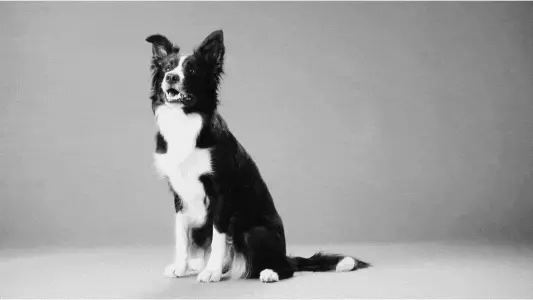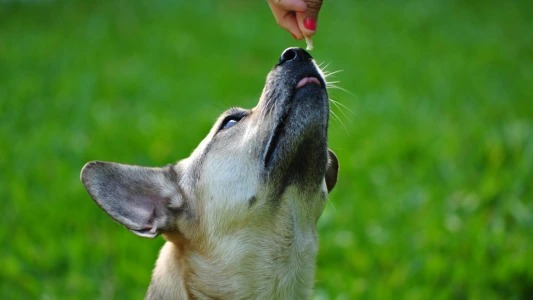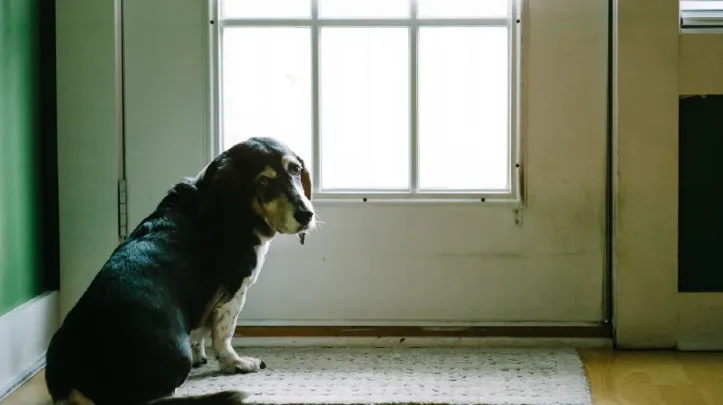How to Potty Train a Puppy to Go Outside

Part of potty training a puppy is teaching them to go outside — and to tell you when they need to. It doesn’t matter if you’re potty training with a crate (like we did) or without one. The only exceptions are mobility issues that make it hard for a dog to get outdoors, or health concerns that cause incontinence.
Healthy pups can follow the same proven step-by-step routine to learn how to communicate clearly when they need to go.
The Proven Routine to Train Your Puppy to Go Outside
The Step-by-Step Potty Training Routine That Builds Communication
The essence of potty training is teaching your dog how to communicate with you. Done right, it’s part of positive training — and it can be completely free from correctional methods because you won’t need them.
What you will need is:
- A week or two of consistent practice
- Training pads to mark the spot for emergency piddles (for the moments when they just can’t hold it while you open the door)
- Patience
- Cleaning products ready to go, to prevent repeat accidents
1. Set a Predictable Routine (and Use Pads as a Backup, Not a Crutch)

Keep mealtimes and toilet opportunities consistent. The more predictable the rhythm, the easier it is for your puppy’s body to adjust. Use the same verbal cue every time — something simple like “toilet” or “go pee.”
Our two were free-fed, and to help with potty training, their bowls stayed within earshot. We could hear when they were eating or drinking, so we knew a toilet break would be coming soon after. That’s when we’d pay closer attention to the early signs — the sniffing, circling, or slow pacing that usually means, “I need to go.”
If your puppy spends daytime hours in their crate, keep the door closed during quiet times so they settle. When they wake up or start moving about calmly, watch for where they head next. Ours would usually wander toward the training pad first — and that’s where the teaching moment happens.
Follow them, open the door, lift the pad, and use your cue word (“go pee,” “toilet,” or whatever you’ve chosen) as you lead them outside. That moment — the pad comes up, the door opens, and they finish the job outdoors — is what connects everything.
The pad becomes an emergency backup, not the main toilet spot. If you’re busy or miss a cue, it’s there for damage control. But when you can, always guide them out. Over time, that consistent redirection teaches that outside is the goal and the pad is just for when you’re not around.
2. Watch for Cues

Every puppy has their own way of saying “I need to go.” Some sniff or circle, others whine, pace, or suddenly get that focused, distracted look. The trick is learning your own pup’s version of that message — and it’s a mix of observation and pattern-building.
It happens both inside and outside of the crate, so keep an eye out whenever they wake, finish playing, or stop mid-activity. Getting them outside in time is far more effective than correcting them after an accident.
We’ve got two brothers, and their signals couldn’t be more different. One goes to the door and whines. The other? He comes over and just sits, staring at me — and that’s when the guessing game begins. Does he need out? Is the water bowl empty? Is the food dish low? Or, more likely, has his brother stolen a chew and dashed into the crate with it?
Those mixed signals are part of the learning curve for both of you. The more you respond and guide them consistently, the clearer their communication gets. Before long, you’ll know the difference between “I’m bored” and “I really need to pee.”
3. Reward Every Success

The moment your puppy finishes doing their business outside, that’s the golden second. Reward right then — not once you’re back inside. The faster the feedback, the faster they connect what earned it.
Keep treats near the door so they’re always within reach. That way you can reward instantly, without dashing around looking for them after your puppy’s already done the job.
At first, use both treats and praise. Say your cue word again, followed by a happy “good boy” or “good girl” in the same upbeat tone each time. Soon enough, the words themselves become the reward — you’ll see it in the tail wag, the head tilt, that instant look of pride.
Just make sure the reward matches the reason. The treat isn’t for going outside — it’s for going to the toilet outside. One of ours still tries to work the system by sitting near the treat bag every time he steps out, even if he’s only had a sniff around. Clever, but not quite the goal.
As your puppy learns, start fading the treats and rely more on verbal praise or quick playtime instead. Keep overall treats to around 10% of their daily diet to avoid overfeeding, especially if you’re using high-value rewards like meat or cheese.
Once outdoor toilet trips start to click, teach a quick “settle on return.” It keeps muddy zoomies off your floors and helps pups switch from “outside hype” to “inside calm.” You don’t need special gear — we used a washable kitchen runner by the sink. A yoga mat or thin rug works too. For ideas, see our best settle mats for dogs round-up post.
4. Handle Accidents Calmly
Accidents are going to happen — even when you’re convinced you’ve finally cracked it.

The key is not to overreact. No shouting, no pointing, and definitely no dragging your puppy over to the mess. It doesn’t teach them what went wrong — it just makes them nervous about going near you next time.
Instead, guide them calmly away and take a breath before you deal with it. Puppies live in the moment, so any reaction that comes after the fact only confuses them.
Clean the spot thoroughly using an enzymatic cleaner — not just antibacterial spray. Enzymatic products break down the scent markers your dog leaves behind. If even a trace lingers, it tells them, “this is the toilet area.” That’s why some pups keep returning to the same corner despite all your accident-proofing efforts.
Once everything’s clean, reset your schedule and carry on as normal. Every accident is a clue — a lesson for you on timing. Maybe they needed out a little sooner, or that extra sip of water after playtime caught you off guard. Adjust, keep your tone steady, and move on.
Consistency wins every single time. Calm handling keeps trust intact, and trust is what makes the rest of your training stick.
Once you’ve cleaned up and reset, it helps to understand why some spots seem to become “repeat offenders.” Dogs read the world through scent far more than sight, and even a trace of old odour can quietly undo your progress. That’s where the right cleaner — and your crate setup — come into play.
Wrapping It Up
Once your puppy understands that outside is the place to go, you’ve built the foundation for all future house manners. From here, it’s just about keeping the rhythm — regular breaks, quick praise, and staying calm when accidents happen.
What starts as routine soon becomes its own kind of language — your pup learns which signals get results, and you learn to understand what each one means. It’s teamwork, not luck.

If you’re also using a crate as part of your setup, you can take this progress even further. Our full guide on Potty Training with a Crate explains how to use dividers, bedding, and structure to speed things up and make the process smoother.
Keep it consistent, keep it kind, and you’ll have a puppy that not only goes outside — but tells you when it’s time.
Has this sparked any ah-ha moments about your pup’s “I’m trying to tell you something!” antics — the ones you’ve just brushed off as aww, cute?
